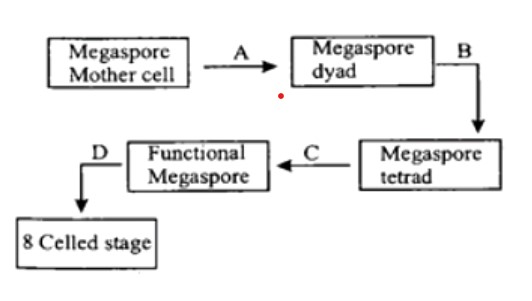
Give the name of the cell division type at A, B, C and D.

A) A-Meiosis-I, B-Mitosis, C-Mitosis, D-Meiosis
B) A-Meiosis-I, B-Meiosis-II, C-No division, D-Mitosis
C) A-Mitosis, B-No 'division, C-Meiosis-II, D-Meiosis-I
D) A-Mitosis, B-Mitosis, C-Meiosis-I, D-Meiosis-I

Answer
341.7k+ views
Hint: After meiosis I and II, the megaspore tetrad is formed, in which three of the four cells die as a result, leaving only one functioning megaspore, and in which three mitotic divisions result in eight cells stages.
Step by step solution:
The megaspore mother cell divides through mitosis to create two nuclei, which travel to opposing polar regions to form a two-nucleate embryo sac. 4 nucleate and then 8 nucleate stages of the embryo sac are produced by further mitosis. The cell wall is established and the typical embryo sac forms after the eighth nucleate stage.
Megasporogenesis is the process by which a megaspore develops from its mother cell. In the micropylar area of the nucellus, ovules typically differentiate a single mother cell that produces megaspores. This mother cell goes through meiosis, producing a linear tetrad of four mesaspores. The four megaspores near the micropylar end typically have one functional megaspore and three degenerating ones. The female gametophyte only develops from the functional megaspore (embryo sac). The functioning megaspore's nucleus divides during mitosis to produce two nuclei, which migrate to opposing poles to form a 2-nucleate embryo sac. The creation of the 4 nuclei and subsequent 8-nucleate stage of the embryo sac is the consequence of two further consecutive mitotic nuclear divisions.
So, option B is correct.
Note: Note that the functional megaspore grows and develops into eggs. Microsporogenesis is the process by which tetrads, whether tetrahedral, decussate, or isobilateral, are formed. The spores that make up the male gametophyte are known as microspores. The egg is fertilised with this male gametophyte to create a zygote.
Step by step solution:
The megaspore mother cell divides through mitosis to create two nuclei, which travel to opposing polar regions to form a two-nucleate embryo sac. 4 nucleate and then 8 nucleate stages of the embryo sac are produced by further mitosis. The cell wall is established and the typical embryo sac forms after the eighth nucleate stage.
Megasporogenesis is the process by which a megaspore develops from its mother cell. In the micropylar area of the nucellus, ovules typically differentiate a single mother cell that produces megaspores. This mother cell goes through meiosis, producing a linear tetrad of four mesaspores. The four megaspores near the micropylar end typically have one functional megaspore and three degenerating ones. The female gametophyte only develops from the functional megaspore (embryo sac). The functioning megaspore's nucleus divides during mitosis to produce two nuclei, which migrate to opposing poles to form a 2-nucleate embryo sac. The creation of the 4 nuclei and subsequent 8-nucleate stage of the embryo sac is the consequence of two further consecutive mitotic nuclear divisions.
So, option B is correct.
Note: Note that the functional megaspore grows and develops into eggs. Microsporogenesis is the process by which tetrads, whether tetrahedral, decussate, or isobilateral, are formed. The spores that make up the male gametophyte are known as microspores. The egg is fertilised with this male gametophyte to create a zygote.
Recently Updated Pages
Capping is a process in which A adenylate is added class 12 biology NEET_UG

Explain in brief the separation and isolation of DNA class 12 biology NEET_UG

Number of testicular lobules in testes is A 250 B 500 class 12 biology NEET_UG

Master Class 11 Chemistry: Engaging Questions & Answers for Success

Master Class 10 General Knowledge: Engaging Questions & Answers for Success

Master Class 10 Computer Science: Engaging Questions & Answers for Success

Trending doubts
What is BLO What is the full form of BLO class 8 social science CBSE

What is meant by exothermic and endothermic reactions class 11 chemistry CBSE

Which places in India experience sunrise first and class 9 social science CBSE

The shortest day of the year in India

What are the major means of transport Explain each class 12 social science CBSE

Which are the Top 10 Largest Countries of the World?




